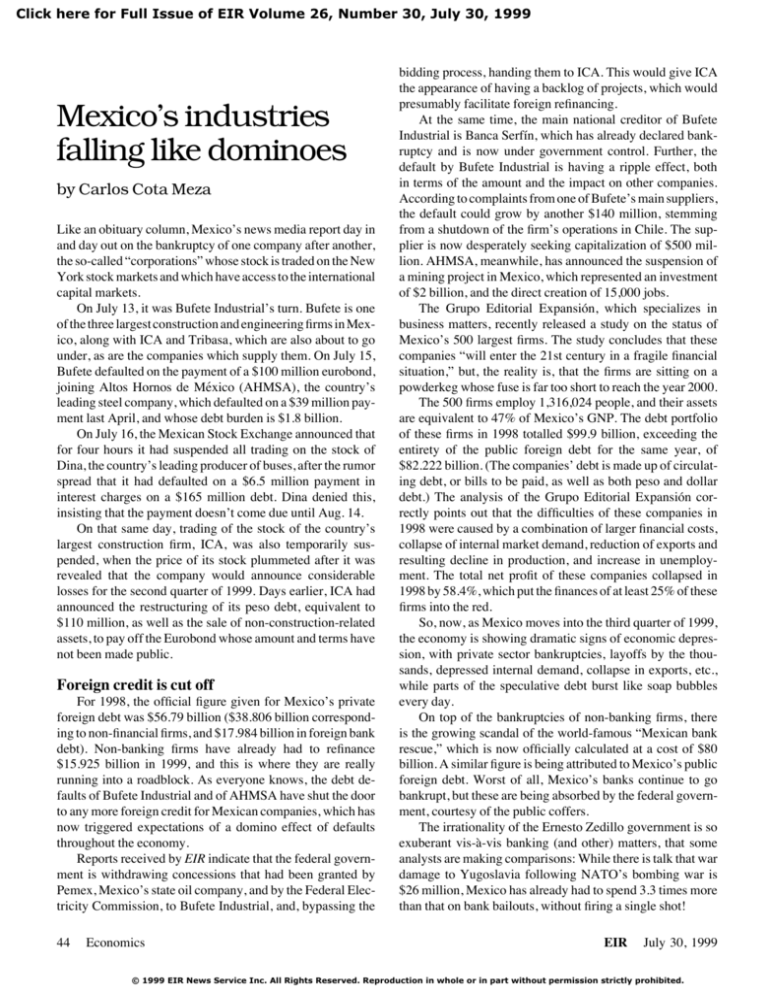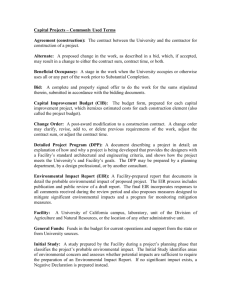
Click here for Full Issue of EIR Volume 26, Number 30, July 30, 1999
Mexico’s industries
falling like dominoes
by Carlos Cota Meza
Like an obituary column, Mexico’s news media report day in
and day out on the bankruptcy of one company after another,
the so-called “corporations” whose stock is traded on the New
York stock markets and which have access to the international
capital markets.
On July 13, it was Bufete Industrial’s turn. Bufete is one
of the three largest construction and engineering firms in Mexico, along with ICA and Tribasa, which are also about to go
under, as are the companies which supply them. On July 15,
Bufete defaulted on the payment of a $100 million eurobond,
joining Altos Hornos de México (AHMSA), the country’s
leading steel company, which defaulted on a $39 million payment last April, and whose debt burden is $1.8 billion.
On July 16, the Mexican Stock Exchange announced that
for four hours it had suspended all trading on the stock of
Dina, the country’s leading producer of buses, after the rumor
spread that it had defaulted on a $6.5 million payment in
interest charges on a $165 million debt. Dina denied this,
insisting that the payment doesn’t come due until Aug. 14.
On that same day, trading of the stock of the country’s
largest construction firm, ICA, was also temporarily suspended, when the price of its stock plummeted after it was
revealed that the company would announce considerable
losses for the second quarter of 1999. Days earlier, ICA had
announced the restructuring of its peso debt, equivalent to
$110 million, as well as the sale of non-construction-related
assets, to pay off the Eurobond whose amount and terms have
not been made public.
Foreign credit is cut off
For 1998, the official figure given for Mexico’s private
foreign debt was $56.79 billion ($38.806 billion corresponding to non-financial firms, and $17.984 billion in foreign bank
debt). Non-banking firms have already had to refinance
$15.925 billion in 1999, and this is where they are really
running into a roadblock. As everyone knows, the debt defaults of Bufete Industrial and of AHMSA have shut the door
to any more foreign credit for Mexican companies, which has
now triggered expectations of a domino effect of defaults
throughout the economy.
Reports received by EIR indicate that the federal government is withdrawing concessions that had been granted by
Pemex, Mexico’s state oil company, and by the Federal Electricity Commission, to Bufete Industrial, and, bypassing the
44
Economics
bidding process, handing them to ICA. This would give ICA
the appearance of having a backlog of projects, which would
presumably facilitate foreign refinancing.
At the same time, the main national creditor of Bufete
Industrial is Banca Serfı́n, which has already declared bankruptcy and is now under government control. Further, the
default by Bufete Industrial is having a ripple effect, both
in terms of the amount and the impact on other companies.
According to complaints from one of Bufete’s main suppliers,
the default could grow by another $140 million, stemming
from a shutdown of the firm’s operations in Chile. The supplier is now desperately seeking capitalization of $500 million. AHMSA, meanwhile, has announced the suspension of
a mining project in Mexico, which represented an investment
of $2 billion, and the direct creation of 15,000 jobs.
The Grupo Editorial Expansión, which specializes in
business matters, recently released a study on the status of
Mexico’s 500 largest firms. The study concludes that these
companies “will enter the 21st century in a fragile financial
situation,” but, the reality is, that the firms are sitting on a
powderkeg whose fuse is far too short to reach the year 2000.
The 500 firms employ 1,316,024 people, and their assets
are equivalent to 47% of Mexico’s GNP. The debt portfolio
of these firms in 1998 totalled $99.9 billion, exceeding the
entirety of the public foreign debt for the same year, of
$82.222 billion. (The companies’ debt is made up of circulating debt, or bills to be paid, as well as both peso and dollar
debt.) The analysis of the Grupo Editorial Expansión correctly points out that the difficulties of these companies in
1998 were caused by a combination of larger financial costs,
collapse of internal market demand, reduction of exports and
resulting decline in production, and increase in unemployment. The total net profit of these companies collapsed in
1998 by 58.4%, which put the finances of at least 25% of these
firms into the red.
So, now, as Mexico moves into the third quarter of 1999,
the economy is showing dramatic signs of economic depression, with private sector bankruptcies, layoffs by the thousands, depressed internal demand, collapse in exports, etc.,
while parts of the speculative debt burst like soap bubbles
every day.
On top of the bankruptcies of non-banking firms, there
is the growing scandal of the world-famous “Mexican bank
rescue,” which is now officially calculated at a cost of $80
billion. A similar figure is being attributed to Mexico’s public
foreign debt. Worst of all, Mexico’s banks continue to go
bankrupt, but these are being absorbed by the federal government, courtesy of the public coffers.
The irrationality of the Ernesto Zedillo government is so
exuberant vis-à-vis banking (and other) matters, that some
analysts are making comparisons: While there is talk that war
damage to Yugoslavia following NATO’s bombing war is
$26 million, Mexico has already had to spend 3.3 times more
than that on bank bailouts, without firing a single shot!
EIR
July 30, 1999
© 1999 EIR News Service Inc. All Rights Reserved. Reproduction in whole or in part without permission strictly prohibited.
The Martin Frankel
swindle: How
high up does it go?
by Dean Andromidas and
Jeffrey Steinberg
On May 5, the Greenwich, Connecticut fire department was
called to a mansion at 889 Lake Avenue, after a private security company reported that the smoke alarms were ringing out
of control in several parts of the building. When the emergency crews arrived, and broke into the house, they found
large piles of documents burning in two fireplaces, and in a
metal file cabinet. The documents that were salvaged from
the fires referenced an elaborate money-laundering scheme.
There was nobody in the building. Greenwich police later
determined that, 24 hours before the fire was reported, the
principal occupant of the mansion, Martin Frankel, had disappeared, along with several women who also lived on the
grounds. A white van had removed enormous amounts of
files, furniture, and so on, and the network of telephones inside
the mansion had been programmed to forwarding numbers.
A May 25 “Verified Complaint of Forfeiture,” signed
by Deputy U.S. Attorney John H. Durham, and authenticated
by FBI Special Agent Joseph P. Dooley, noted that Greenwich police found 80 computers, connected to fiber-optic
lines and several satellite receivers at the mansion. “Paperwork recovered during the search,” the complaint stated,
“revealed that the house at 889 Lake Ave. had been operating
as a brokerage office with an active trading floor, and that
the computer and telecommunications equipment was used
to provide a continual flow of financial and trading market
information and to assist in the execution of securities and
commodity trades.”
In the two and a half months since Frankel’s disappearance, the 44-year-old Toledo-born stock swindler, who had
had his license permanently lifted by the Securities and Exchange Commission (SEC) in 1992, has been the subject of
thousands of lines of news copy, particularly in the Wall Street
and London financial press. Interpol has issued a “code red”
all-points bulletin for his arrest. But, Frankel has so far managed to stay one step ahead of the international police dragnet,
spending his way across continental Europe, purportedly using $10 million in diamonds to fund his flight. Frankel has
been characterized as a world-class con-man who stole as
much as $3 billion from a string of small U.S. burial insurance
companies, and was able to fast-talk unsuspecting insurance
executives, a Catholic priest, a Vatican bishop, a top Wall
EIR
July 30, 1999
Street lawyer, a former high-powered U.S. ambassador, and
Kroll Associates, the world’s greatest private investigative
firm, into his schemes. He also is aleged to have talked a bevy
of women into sado-masochistic sex.
An extensive EIR investigation on two continents, however, has revealed a very different picture. While the financial
press has characterized the Woody Allen look-alike Frankel
as Hugh Hefner, Bernie Cornfeld, Robert Vesco, and Michael
Milken all rolled into one, EIR’s investigation shows him to
be a neurotic front-man for a fascinating collection of wellknown New York-area political and financier figures, with
high-level ties to Wall Street, to the far right wing of the
Republican Party, and to organized crime. Several American
sources interviewed for this story speculate that, if and when
the full Frankel saga is unravelled, New York City Mayor and
wanna-be U.S. Senator Rudolph Giuliani’s political career
will not be worth a plug nickel.
The boys from Greenwich
Greenwich and Stamford, Connecticut are upscale New
York City suburbs, widely referred to as Wall Street’s “offshore,” as the result of the proliferation of hedge funds, commodity-trading companies, and other speculators who set up
shop there over the past decades.
The region’s first notorious fast-money operator, Marc
Rich, is still a fugitive from American justice, after then-U.S.
Attorney Giuliani let the metals trader escape prosecution for
a variety of crimes, including “trading with the enemy” (he
violated the U.S. trade embargo on Iran during the heyday of
Khomeini). Rich now operates out of a luxury office building
in Zug, Switzerland, and, despite his fugitive status, is the
largest supplier of nickel to the U.S. Mint.
Long Term Capital Management (LTCM)—whose September 1998 losses on the Russian currency and bond markets
nearly blew out the global financial system, until the Fed
stepped in to organize a $4 billion bailout—operates to this
day out of modest offices in Greenwich. Frankel hobnobbed
with some other hedge-fund superstars who camped out in
southern Connecticut, including Charles Davidson, former
partner with Michael Steinhardt, in Steinhardt Partners, once
the second-largest hedge fund in the world, behind George
Soros’s Quantum Fund.
A New York City law enforcement source explained to
EIR the reasoning behind the swindlers’ migration to southern
Connecticut—and it wasn’t to escape the crime on the streets
of Manhattan.
The U.S. Attorney’s Office for the Southern District of
New York, one of the largest offices in the country, is stacked
five levels deep with specialists in financial fraud and organized crime. Manhattan District Attorney Robert Morgenthau
has earned the nickname, “The Sheriff of Wall Street,” for his
long-standing appetite for high-profile financial conspiracy
prosecutions, typified by his 1980s tackling of the Bank of
Credit and Commerce International (BCCI).
Economics
45









